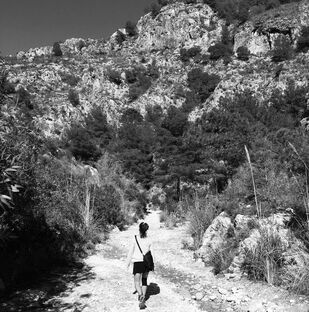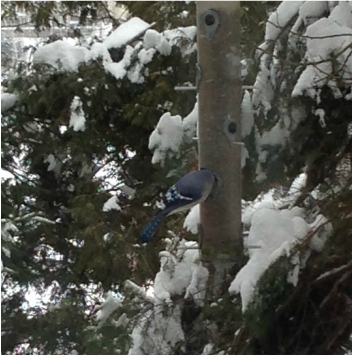Part 1 of a 4-day experiment: Starting point A close friend faced a snowy two-hour drive to a meditation retreat, over the holidays. Three days of silence. No talking or reading, no radio or TV, no phone or computer. No eye contact either. In my opinion, it takes guts to commit to three full days of meditation and silence, even for someone who meditates once a day if not twice. We have meditated together many times. My longstanding interest in meditation was reawakened a few years ago through a Mindfulness-Based Stress Reduction (MBSR) course, modeled on classes developed by Jon Kabat-Zinn, Ph.D., at the University of Massachusetts Medical Center. The course introduces mindfulness through guided meditation, group dialogue, and home practice. In hospitals it has been used as a complement to conventional medical treatment of illnesses, chronic pain, anxiety and depression. For the rest of us, the course is a practical intro. In my case, it made meditation part of my life. As a coach, I introduce meditation in five-minute sessions to those clients who want to learn how to quiet their minds and avoid the distractions of too many crashing thoughts and feelings. I have also led longer meditation sessions over Skype. Yes, you can meditate together at a distance. In my personal life, however, I have fallen off the daily meditation wagon in recent months and taken to meditating only when the mood strikes. With the holidays coming up, I was looking forward to restarting daily meditations while away in the country. Against this backdrop, and with my friend’s first-ever meditation retreat in mind, I called while she was driving in the snow to the centre: “Would you like it if I meditate with you each day? I’ll keep you company.” She was delighted so I said excitedly: “Should we set a time to ‘connect’ or just see what happens?” Not wanting to pin either or us down, I answered my own question: “How about I just find you in outer space each day?” She loved the idea of connecting at a distance, or, rather, in outer space. So did I. Mindfulness is an emotionally accepting and non-reactive state of mind. When one is mindful, we simply accept whatever arises, without judging it as good or bad. Mindful meditation calls for us to be concerned with whatever arises in the here and now, and having the self-awareness to return to port whenever thoughts threaten to take us elsewhere. Part 2 of a 4-day experiment: Learning how to connect in outer space  Late in my first afternoon in the country, as dusk fell, I realized my friend would at that time be filing into the first meditation session of her three-day retreat. So I decided to fit in a quick meditation session of my own and connect with her, to keep my end of the bargain. I did make a promise. To set the stage I made a fire and once it was blazing sat before the fireplace in an old wooden chair without a back. Slightly uncomfortable. I set the meditation app on my phone for 20 minutes. My front was warm and my back was cold. I was uncomfortable and very aware of it. I sat straighter, to ease my sore back. My throat was tight and I kept swallowing. The air was dry. I looked for my friend by scanning the horizon of outer space – or was it inner space? – until I found her! This settled my mind. My breathing, too. I was still not comfortable in my back or shoulders, but tried to be mindful about this, and not let it get in the way. I was happy when the app’s gong dinged to end the session. Even happier that we had connected. Part 3 of a 4-day experiment: The morning after I had planned after my previous meditation to do it again first thing after my morning coffee, so when the time came I was ready, mentally, to sit calmly and meditate. To ready myself physically, I chose a proper chair and stuffed a cushion behind my back, then put on an extra fleece top for warmth. My husband joined me, too. My mind was quiet – the right mental state. No racing thoughts competed for attention. I focused on breathing: taking a breath in while rolling my eyes up, then lowering my eyes when I exhaled. I noticed a dominant feeling around my left eye – like the shadow thrown by a cloud on a sunny summer day. This generated thoughts about left brain and right brain processes. I caught myself, dropped the brainy stuff, and concentrated instead on diffusing the feeling around my eye. I then remembered I had to look for my meditating friend on her retreat, as planned. I felt I was hovering 100 feet in the air, scanning the retreat centre. I found her easily, without really trying, among the other meditators. My mind was quiet and I felt myself smiling. Surprisingly, one of my old clients appeared and I said something to him. As soon as I realized I was lost in a coaching conversation, the app gong dinged and the 30-minute session was over. My husband and I turned to one another and both said: “Meditation is a good thing, isn’t it?” Early in this session I realized that, to document my process of meditation while also keeping the spirit of mindfulness, I had to stop trying to memorize what was going on in my mind. I had to trust I would be able to capture the essence of the meditation through stream of consciousness notes right after the session. This blog is an edited version of those notes. Part 4 of a 4-day experiment: Meditating with company in the house I was looking forward to this meditation and, even though friends were visiting I had no difficulty getting to it, pulling up a chair, and setting my app timer.
I settled into my breathing almost immediately after closing my eyes. I felt right away over my right eye the shadow that had hovered over my left eye in the previous meditation. For a moment I thought I’m neither left or right brain dominant – as if this should be a point of pride. I continued to observe my breathing. I noticed I was trying again to describe in words the meditation experience to help me remember interesting details for this blog. (This was despite the commitment described above to drop the memorization and trust to post-meditation notes.) I managed to stop converting the experience into words and went back to my breathing. (This repeated desire to wordify the meditation reflects my interest in talking things out)! I then remembered – again – I was supposed to be looking for my friend. I scanned a large room filled with rows of meditators in the lotus position and rows of meditators seated in chairs. I found her in a chair and we sat together until the feeling of connection faded. I lost any sense of time. I had an overwhelming feeling that, on my deathbed, I would like a certain person to be there with me. Heat filled the space around my heart and radiated. My eyes filled with tears. The gong dinged, I opened my eyes, and wiped away the tears. Experimentally, Mindfully and Mindafully yours, Coach Minda
8 Comments
While I am a good short order cook and can make a healthy and tasty meal without a recipe, I don’t bake much. If and when I bake, I use a recipe – to a point. There are those who suspect the reason why my baking isn’t famously delicious is this bias for recipe tampering. It generally amounts to reducing the sugar or oil – putting healthfulness ahead of flavor – or making impromptu substitutions.
Over the holidays, with still a few dozen-honey crisp apples left over from the four bushels I bought this fall, I decided baking an apple cake would be a good idea. I would make a large one, keep most of it for the family and give away a portion. I followed the recipe perfectly. No reductions or substitutions. Full portions of sugar and spice and oil. I peeled 15 large apples, then turned to my trusty hand held slicer for the slicing. The slicer is extremely quick – appealing to my short order mentality – and sharp. So I have one rule – always use the hand protector over whatever I’m slicing. Only this time I did not use the hand protector, reasoning that the apple core would provide protection as long as I rotated each apple carefully. This went well for 14 apples then, while slicing the last one, I yelped. I must admit that I had simultaneously tried to speed up the slicing while my mind drifted off to another subject. Two fingertips were bleeding. Throbbing, too. I grabbed the cleanest dishcloth and wrapped my fingers tightly to stem the blood flow. I washed and disinfected my fingertips but found the sting was worse than the throb. I made a bandage. As blood soaked through the cloth, then through the gauze and tape, I managed to layer the first pan with the batter, added the apples, and then another layer of batter. Just like the recipe said. I put it in the oven, at the prescribed temperature, then had some time to find a solution to stop the bleeding. I wrapped my fingers again with fresh gauze, held them in the air and applied pressure. I also set a timer for 15 minutes. When the buzzer went off, the bleeding had mostly stopped. As I re-bandaged, I noticed that a slice of skin was missing from the side of one fingertip – about the size of a match head. Also missing was a similarly sized piece of fingernail. I couldn’t quite risk giving an apple cake gift with finger bits as added ingredients so I set out to make fresh cake. This time, I didn’t break my cardinal rule of always, without fail, using the hand protector when slicing. I am proud to say, both cakes turned out exceptionally well. And, ten days later, my fingers are healing perfectly. Apple cake lessons that can apply to other slices of one’s life.
Mindfully yours, Coach Minda, |
My family, relationships, movement, nature, flexibility of mind, exploration of alternative perspectives & openness are central to my life.Archives
December 2021
|
Private and confidential
|
Connect with me
|







